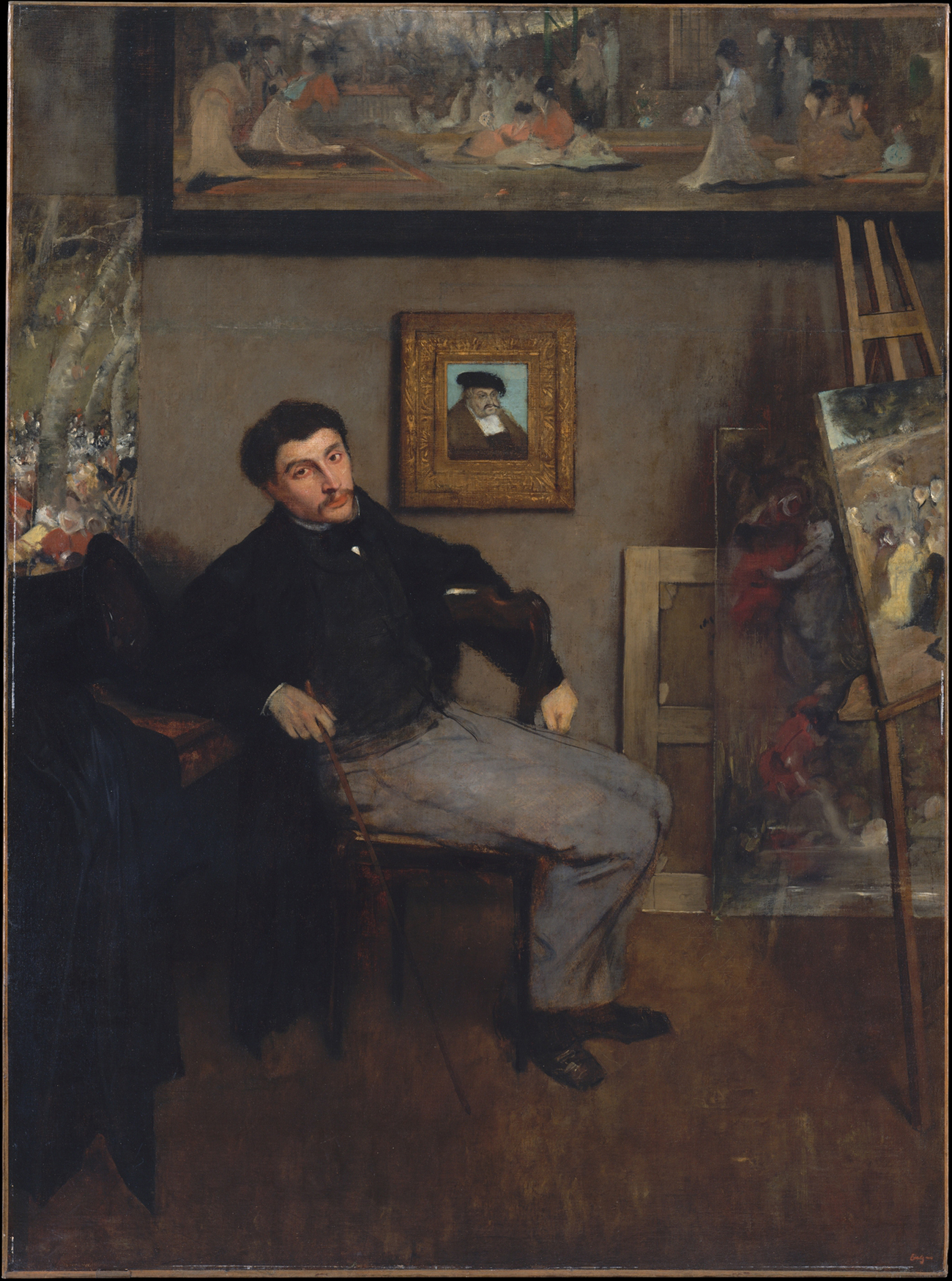This 1866 portrait shows a French noblewoman in a peignoir (French for woman’s dressing gown) in the private quarters of the Château de Paulhac, her family castle. Everything is pink ruffles, luxury, and lace. Her outfit and surrounding furnishings are French through and through.
But if you look carefully, there are some things that seem out of place—objects tucked away in the background that look like they may have come from Japan or China. What are these things, and why did the artist include them in the portrait?

Portrait of the Marquise de Miramon, née Thérèse Feuillant, 1866, Jacques Joseph Tissot. Oil on canvas, 50 1/2 x 30 3/8 in. The J. Paul Getty Museum, 2007.7. Digital image courtesy of the Getty’s Open Content Program
What Are These Objects?
At the bottom left of the portrait, there’s a small gold folding screen covered in white cranes. In Japan such a screen would have been used in front of a fireplace. Art historians are pretty sure that the original object depicted here is from Japan (rather than made in Europe in the Japanese style), because of its size and the care taken in painting the cranes, a popular subject of similar screens found in Japan.

Portrait of the Marquise de Miramon, née Thérèse Feuillant (detail of screen), 1866, Jacques Joseph Tissot
On the mantle, there are three vases of unknown origin. The most visible one, at the far right, takes the shape of a fish. Experts aren’t quite sure what to make of this, as it appears to have the head of a dragon, too!

Portrait of the Marquise de Miramon, née Thérèse Feuillant (detail of vase), 1866, Jacques Joseph Tissot
This object might be Chinese, perhaps relating to a folktale in which the first carp to swim upstream and over a waterfall in the Yellow River, called Dragon’s Gate, would transform into a dragon. (The story was an allegory for a poor villager or scholar who defies the odds and passes the civil service exams required to become a powerful government official, but it’s not clear whether this meaning held any water with the European collectors—pun intended.)
Or, the vase may be a Japanese or European interpretation of a Chinese object. During the early days of Japonisme (literally “Japan-ism,” the European fad for Japanese decorative objects), collectors and dealers had trouble telling a Chinese import apart from a Japanese import. To make things more confusing, European artists began to make work that resembled both.
What Does the Presence of These Objects Tell Us?
To answer this question, we need to do some digging into history. I turned to Getty paintings curator Scott Allan and art historian Gabriel Weisberg, who helped guide me to some interesting answers.
This portrait depicts aristocrat Thérèse-Stephanie-Sophie Feuillant—the Marquise de Miramon—dates to 1866, and reflects the emerging European trend of Japonisme.
Japonisme sprang up after the relaxation of Japan’s isolationist policy in 1853, which had limited its diplomatic and trade relationships with other countries. The appearance of Japanese goods in Europe created such a frenzy that critic Philippe Burty was prompted to coin the term. Artists and aristocrats alike were particularly excited about these imports, which included porcelain and painted screens. The painter of the portrait, Jacques Joseph Tissot, had such an affinity for objects from Asia that one art historian has even called them his “signature.”
Just look at Edgar Degas’ portrait of Tissot, shown below, which shows Tissot seated in front of a large picture in a Japanese style.

James-Jacques-Joseph Tissot, about 1867–68, Edgar Degas. Oil on canvas, 59 5/8 x 44 in. The Metropolitan Museum of Art, 39.161. Rogers Fund, 1939. www.metmuseum.org
So what do these objects mean in the Getty’s portrait of the Marquise? In European art of the time, Japanese objects were symbols of upper-class style and taste, though they took on different meanings for men and women. In portraits of men, these objects were meant to suggest their role as explorers and connoisseurs of objects from foreign lands. But in portraits of women, the objects tended to portray them as consumers who were merely interested in keeping up with trends.
Tissot’s portrait of the Marquise, however, indicates that she’s not so easily stereotyped. Her dress, considered to be informal—believe it or not!—and the setting of her bedroom or dressing room, an intimate space, suggests that she kept these objects for private viewing rather than displaying them to impress guests.
In this single artwork, we find multiple examples of cross-cultural influence. To me, this suggests the value of being attentive to the complexities, origins, and journeys of things and ideas, aesthetic and otherwise.
Interested to explore more on this theme? Read more about evidence of cross-cultural exchange with China and Japan as seen in our collection.
_______
Got your own questions? Join us for #AskACurator Day on Twitter this September 14—or leave me a comment! And explore answers to more art questions in our #QuestFest series on the Getty Iris.





Comments on this post are now closed.